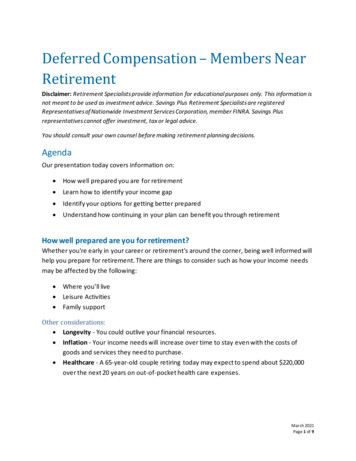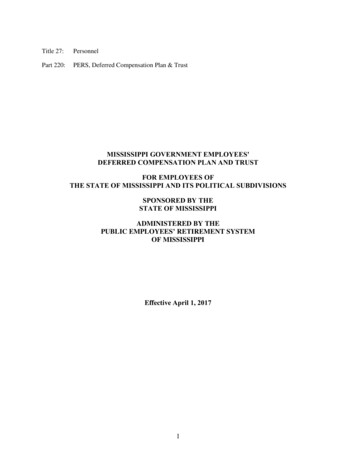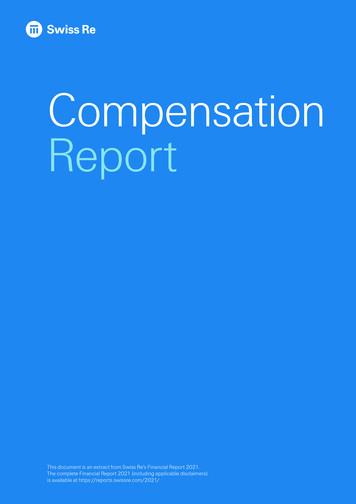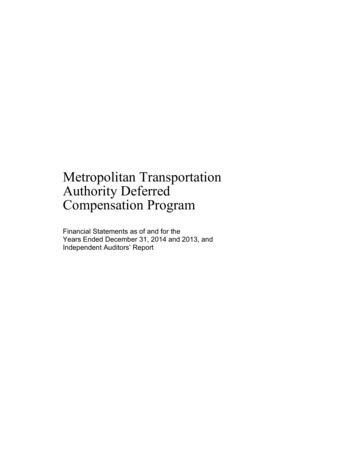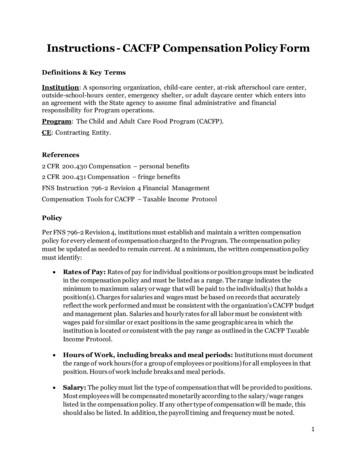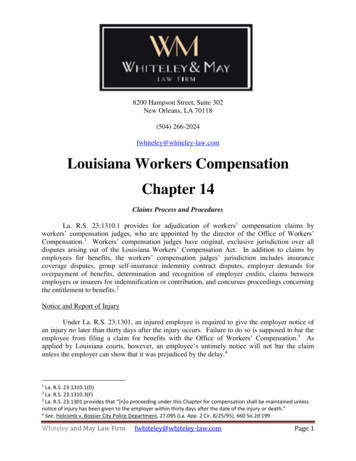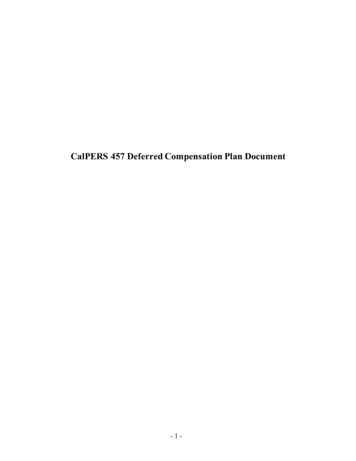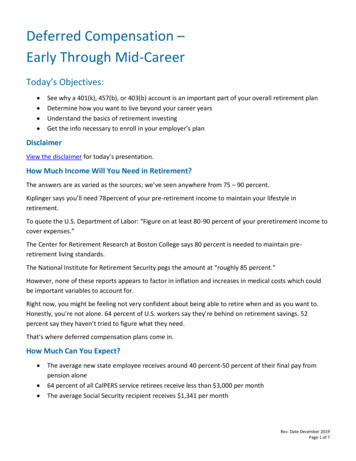
Transcription
Deferred Compensation –Early Through Mid-CareerToday’s Objectives: See why a 401(k), 457(b), or 403(b) account is an important part of your overall retirement planDetermine how you want to live beyond your career yearsUnderstand the basics of retirement investingGet the info necessary to enroll in your employer’s planDisclaimerView the disclaimer for today’s presentation.How Much Income Will You Need in Retirement?The answers are as varied as the sources; we’ve seen anywhere from 75 – 90 percent.Kiplinger says you’ll need 78percent of your pre-retirement income to maintain your lifestyle inretirement.To quote the U.S. Department of Labor: “Figure on at least 80-90 percent of your preretirement income tocover expenses.”The Center for Retirement Research at Boston College says 80 percent is needed to maintain preretirement living standards.The National Institute for Retirement Security pegs the amount at “roughly 85 percent.”However, none of these reports appears to factor in inflation and increases in medical costs which couldbe important variables to account for.Right now, you might be feeling not very confident about being able to retire when and as you want to.Honestly, you’re not alone. 64 percent of U.S. workers say they’re behind on retirement savings. 52percent say they haven’t tried to figure what they need.That’s where deferred compensation plans come in.How Much Can You Expect? The average new state employee receives around 40 percent-50 percent of their final pay frompension alone64 percent of all CalPERS service retirees receive less than 3,000 per monthThe average Social Security recipient receives 1,341 per monthRev. Date December 2019Page 1 of 7
The average California state retiree has as least three years between retirement and Social SecurityeligibilityThe average annual inflation rate is 3.22 percent which doesn't sound too bad until we realize thatat that rate prices will double every 20 yearsWhich Plan Is Right for You?The Savings Plus program is available to state employees only. If you work for a public agency or a school,contact your employer to see what types of deferred compensation plans they offer. The informationpresented today on 401(k) and 457(b) plans will apply regardless of plan sponsor.Savings Plus offers two different kinds of plans to choose from: a governmental 457(b) plan and a 401(k)plan. You can enroll and participate in either, or both, plans. From a participant’s perspective, these twoplans are very similar, but there are some important distinctions.A key difference between 401(k) and 457(b) plans is that 457(b) plans have no tax penalty for takingmoney before age 59½. However, unlike a 401(k) plan, access to your money is limited to a distributableevent, such as a hardship, separation of service or early retirement.For more details about the differences, please refer to the 401(k)/457(b) chart on the Savings Plus website.If you do decide to participate in both plans, you can contribute up to the legal maximum in each plan. Ifyou are contributing to a 403(b) plan, you can contribute to the legal maximum to it and to the SavingsPlus 457(b) plan [but not to the 401(k) plan].Current 401(k) and 457(b) Plan Contribution LimitsMaximumcontribution limit,less than age50Contribution limitplusAge Based CatchUp, at least age 50Traditional 457(b) Catch UpContribution limit, 3 years orless from your normalretirement age401(k) Pre-tax/401(k)Roth 19,000 25,000 25,000 (use Age-Based CatchUp)457(b) Pre-tax/457 (b) Roth 19,000 25,000 38,000TOTAL 38,000 50,000 63,000Plan TypeIf you’re under the age of 50, the left column shows how much you may be able to contribute this year. Ifyou’ve achieved age 50, look at the right column.Rev. Date December 2019Page 2 of 7
Assuming your includible compensation exceeds the contribution limits, you may be able to contribute toyour Savings Plus account as much as 50,000 this and in future years. The combined 401(k) and 403(b)contributions cannot exceed 19,000 and 25,000 respectively.If you plan to retire within the next five years, you may be able to contribute even more.Exemption for Public Safety EmployeesEffective January 2016, the Defending Public Safety Employees’ Retirement Act provides that public safetyemployees age 50 or older who retire or separate from service are exempt from the additional 10 percentearly withdrawal tax on their 401(k) account. This includes distributions from qualified definedcontribution plans when a participant separates from service while still serving as a Public Safetyemployee. It does not apply to any IRA money rolled into a Savings Plus account.To take advantage of this benefit contact your Human Resources department to confirm yourclassification. You’ll need to check the appropriate box on the Benefit Payment booklet to ensure thedistribution is classified correctly.NOTE: If you are a public safety employee and you do not check this box, the tax exception will not beapplied.Regardless of your agency or department, there are specific contribution limits that apply.Contribution Limitations401(k) – contributes pre-tax dollars, allows for in-service withdrawals under certain conditions, must waituntil age 59½ to avoid 10 percent early withdrawal tax (some exceptions apply).Roth 401(k) – contributes after-tax dollars for tax-free growth potential when certain conditions are met.Same contribution limits as 401(k) pre-tax.457(b) – contributes pre-tax dollars and has no 10 percent early withdrawal tax regardless of age butcannot take a withdrawal while still employed with the state (except for Unforeseeable Emergencies).Roth 457(b) – contributes after-tax dollars for tax-free growth potential when certain conditions are met.Roth 457(b) has same contribution limits as 457(b) pre-tax.Savings Plus offers you flexibility in how you save for retirement. You can choose to make pre-tax, Roth(after-tax) or both types of contributions in either the 401(k) Plan, 457 Plan or both.Each type of contribution has its own benefits. You can contribute on a pre-tax or Roth after tax basis toSavings Plus. Pre-tax contributions come out of your pay before taxes are deducted, lowering your taxabletake-home pay. Any earnings on your savings grow tax-deferred until withdrawn. Roth contributions comeout of your pay after taxes are deducted, but your contributions and related earnings may be withdrawntax-free at retirement if certain criteria are met.Small Increases Can Make a Big DifferenceRegularly increasing contributions to your Savings Plus account can help you feel confident that whatyou’re doing now can positively impact your longer-term goals. You may want to consider your plannedRev. Date December 2019Page 3 of 7
lifestyle in retirement, inflation, rising healthcare costs, and longevity as factors to help you make yourdecision to increase.How Do You Want to Build Your Portfolio?Savings Plus offers you three approaches for investing through the Plans:1. Do it for me2. Manage it for me3. Do it myself1. Do It for MeYou select the target date fund closest to the year you plan to start taking withdrawals. That may or maynot be the year you plan to retire.Target Date Funds offer the convenience of a single, diversified investment strategy that automaticallybecomes more conservative as the fund approaches a specific retirement date. The Target Date Funds arecomprised of the Savings Plus core investment funds, Savings Plus’s investment line-up featuring a broadrange of asset classes with differing levels of risk/reward potential.Each fund invests in a professionally selected mix of investments tailored for investors who plan to retireand take a distribution close to the target date designated in the fund’s name (generally assumed to bewhen they reach age 62).Over time, the fund will automatically become more conservative with greater emphasis on investmentsthat provide for income and preservation of capital, and less on those offering the potential for highergrowth. Keep in mind that the principal value in the fund isn’t guaranteed at any time, including the targetdate.Your financial concerns don’t stop at retirement. They just change. That’s why the investment mix for eachfund is managed in a way that helps you grow your retirement savings over the long term while seeking toreduce volatility and provide income.2. Manage It for MeEnroll in our professional managed account solution, Nationwide ProAccount .Through this service, you complete a Risk Tolerance Questionnaire, which is used to guide the professionalaccount managers as they allocate, invest and rebalance your account. There is a fee for this service, butwe believe you’ll find it to be very competitive.Of course, no matter which approach you choose, you have Savings Plus Retirement Specialists to help youput it into effect.Keep in mind that we cannot offer investment, tax or legal advice. However, we do offer plenty of onlineresources that can help you make decisions as you participate in Savings Plus.Rev. Date December 2019Page 4 of 7
3. Do It MyselfWith this approach, you do it all.You select, mix and match from the Savings Plus core fund options. You monitor your account’sperformance against your Investor Profile, your investment strategy and your goals. You rebalance youraccount regularly.You can even go outside for more investment options by maintaining a Schwab Personal ChoiceRetirement Account. PCRA “opens a window” to a world of investment options and may be best suited forparticipants who consider themselves experienced investors. There no explicit fees in your Savings Plusaccount but there may be PCRA transaction fees which are highlighted in the PCRA pricing guide on theSavings Plus Website.If going it alone is not for you, Savings Plus offers two forms of asset allocation funds to “help you do it.”Investing in a Volatile MarketRegardless of changes to the funds that are upcoming, when you are investing, you need to be aware ofmarket risk: the potential for investments to lose value due to market fluctuation or volatility. Market riskis always there. You can’t avoid it.History shows that investment markets have grown over time despite short-term ups and downs. In fact,these fluctuations can actually create buying opportunities that may lead to greater earnings over time.Investing is all about striking a balance between market risk and return. Rather than trying to avoid marketswings, understanding some key principles for long-term investing can help you navigate a sometimesvolatile market.When investing for your retirement, it’s important to have a plan, understand your investment style andcontribute regularly. Keep in mind investing involves risk, including possible loss of principal.3 Key principles when investing for the long term:1. Have a plan. It’s easier to take a long-term view if you understand where you want to go.2. Know your investment style and determine the asset allocation that is right for you. Howcomfortable are you with seeing your portfolio go up and down.3. Contribute regularly and stay cool when markets become volatile. Making investment decisionsbased on hunches or trying to time the market often leads to dollar losses and missedopportunities.Act Now! It’s never too early, it’s never too late.Set up your 401(k), 403(b) or 457(b) account right away.If you’ve already waited “too long” then make a commitment today, don’t wait any longer.Start with a comfortable amount then opt for “auto-increase”.Get a raise recently - spend it on yourself.Rev. Date December 2019Page 5 of 7
No one ever complained that they had too much saved for retirement.Take control of your financial future today.Next Steps Call Savings Plus at (855) 616-4776Log in to your account at the Savings Plus website.Reach out to your plan provider or personnel office for more info on your employer’s 401(k),457(b), or 403(b) planDisclaimerRecordkeeping, education and administrative services for Savings Plus are provided under contract byNationwide, a leading provider of financial services and one of the first companies – more than 40 yearsago – to offer retirement-savings plans for public employees like you.Both Savings Plus and Nationwide are committed to transparency about how we serve participants; thus,we ask that you review the information on this slide and understand any of the disclosures you may seethroughout this presentation.Investing involves market risk, including possible loss of principal. There is no guarantee that fund,investment option or portfolio objectives will be met nor that any investment strategy, including assetallocation and diversification, will generate a profit or avoid losses, especially in a down market. Actualinvestment results will vary, depending on your investment and market experience.Savings Plus Retirement Specialists are registered representatives of Nationwide Investment ServicesCorporation, member FINRA. Neither Nationwide nor any of its representatives give investment, legal ortax advice. Please consult your own counsel before making decisions about retirement plan participation.Target date funds are managed to become more conservative as the year in the fund’s name approaches.There is no guarantee that lifestyle or target date fund objectives will be met or provide enough income ator through retirement. These funds invest in other funds; therefore, in addition to the fund’s charges andexpenses, an investor indirectly pays a proportionate share of the underlying funds’ charges and expenses.The Schwab Personal Choice Retirement Account (PCRA) self-directed brokerage window is offered for anadditional fee by Charles Schwab & Co., Inc, member SIPC, which is not affiliated with Savings Plus orNationwide.Nationwide ProAccount is the managed account solution for Savings Plus participants and available for afee. Investment advice for Nationwide ProAccount is provided by Nationwide Investment Advisors, LLC(NIA), which has retained Wilshire as Independent Financial Expert for Nationwide ProAccount. NIAexercises discretionary authority to allocate and rebalance a participant’s account to implement the adviceWilshire provides. Wilshire is a service mark of Wilshire Associates, Inc., which is not affiliated with SavingsPlus, Nationwide or NIA.Rev. Date December 2019Page 6 of 7
Nationwide, Nationwide ProAccount and My Interactive Retirement Planner are service marks ofNationwide Mutual Insurance Company. 2015 Nationwide.NRM-4952CA-CA.7 (11/19)Rev. Date December 2019Page 7 of 7
If you do decide to participate in both plans, you can contribute up to the legal maximum in each plan. If you are contributing to a 403(b) plan, you can contribute to the legal maximum to it and to the Savings Plus 457(b) plan [but not to the 401(k) plan]. Current 401(k) and 457(b) Plan Contribution Limits . Plan Type . Maximum contribution limit,


